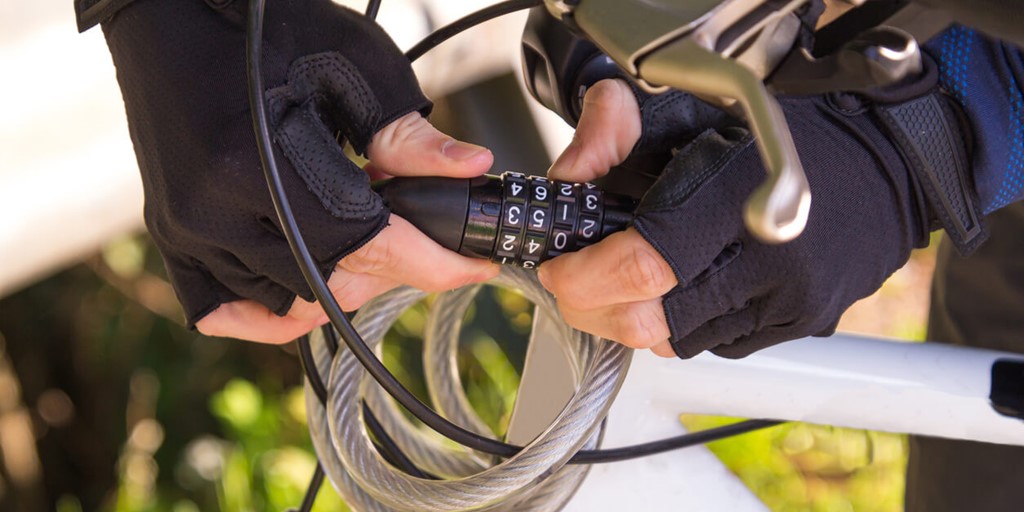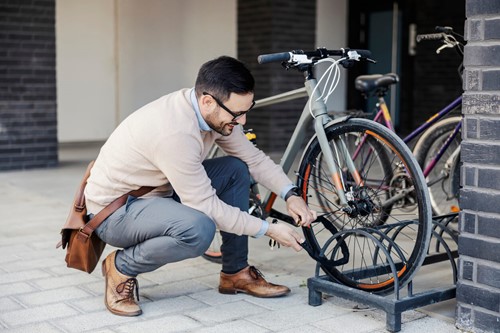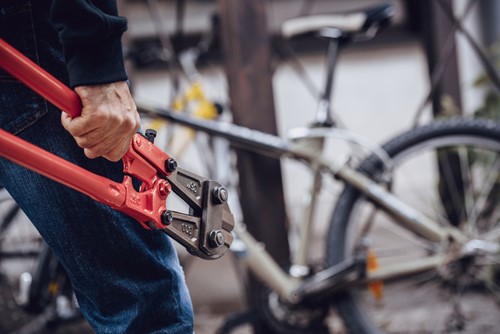

Bike theft is rife in the UK, with a bike being stolen every 7 minutes in 2022 and only 1.7% of cases resulting in someone being charged. There’s no better time to get updated on the latest prevention tactics.
Here’s our ultimate guide to bike security alongside expert advice, so you can keep yours safe and improve your chances of recovering a stolen bike in the worst-case scenario.
Table of contents:
9 ways to up your bike security
- Purchase a secure bike shed
- Make your bike easily identifiable
- Avoid sharing your bikes on social media
- Ensure your home is secure
- Store your bike out of sight
- Park your bike securely
- Take removable items with you
- Invest in location-tracking technology
- Consider specialist bike insurance
How to retrieve your stolen bike
- Track your bike electronically
- Notify local authorities and publicise the theft
- Contact your insurance company
9 ways to up your bike security
1. Purchase a secure bike shed
Locking your bike securely out of sight is one of the most effective ways to prevent theft.
Most opportunists will choose a poorly secured bike left in a front or rear garden over the risk of breaking into a bike shed, particularly if it is constructed from robust material and has a tough lock.
Plastic or wooden sheds are better than nothing, but opting for a more budget-friendly bike shed could cost you more in the long run, as they’re more vulnerable than their metal counterparts.s
Andy Heath, a bike security expert at Asgard, adds:
“Dedicated metal bike sheds fall into two categories—light gauge and heavy gauge.
Light gauge sheds are made from thin metal and have no base, often secured by a small padlock. The heavy-duty metal sheds will have dedicated locking systems and a metal base.
These high-end sheds often carry a Secured by Design seal of approval or carry an additional accreditation such as a Locksmiths rating or insurance approved, so you can be sure they have been independently tested against theft.”
Both Asgard Sheds and Trimetals Protect-a-Cycle have been awarded the Secured by Design seal of approval, meaning the Association of Chief Police Officers has named them as their preferred products for deterring criminals.
Opting for a shed with either no windows or those that are blacked out reduces the chances of theft, as thieves are much less likely to target a shed if they can’t see its contents.
Battery-operated alarms are another effective deterrent, as they significantly reduce the timeframe the thief has to break into and remove a bike from your shed before getting caught.
2. Make your bike easily identifiable
Many opportunists will keep marked and registered bikes off their radar—when there’s a high risk of a stolen bike being identified, they’re much more likely to be caught and arrested.
This is great news for cyclists hoping to protect their bike from theft, especially since the steps involved are relatively simple and inexpensive.
The registering process involves recording details such as your bike’s brand, model, and frame number, so there’s a high chance of you retrieving it if it’s stolen.
Secured by Design have a list of approved bicycle security companies providing marking products and accredited registers.
Bike Register is one of the most well-known among cyclists, and their scheme includes a warning label you can attach to your bike to alert thieves it has been registered.
3. Avoid sharing your bike on social media
It’s easy to underestimate the effects that posting on social media can have. Many people post photos of themselves online during holidays, for example, without realising they’re advertising that their house is empty.
The same goes for unwittingly exposing the fact you’ve just purchased a new bike on your Facebook or Instagram page.
A spokesperson from Cycleplan said: “While posting photos of your bike online won’t invalidate your insurance policy, we would encourage you to resist doing so, as it could certainly increase the risk of theft.”
Social networking sites aren’t the only culprits behind bicycle theft. Dorset Police believe that cyclists accidentally sharing their home address data on route-sharing apps have been targeted by thieves.
A quick check of your privacy settings is always a good idea, as this is something many people could overlook—you could be leading thieves straight to your bike without even realising it.
4. Ensure your home is secure
Following on from our previous point, ensuring your bike is stored securely at your home address is paramount for avoiding theft, even if you did accidentally reveal the fact you own a bike to a potential thief.
CCTV is a great idea, alongside a sign clearly stating it’s in operation. Bright outdoor lighting that illuminates your garden is another deterrent, especially if there are few obstacles or dark corners that thieves could use to obscure themselves from view.
Storing your bike somewhere safe indoors or within a bike shed goes without saying. It’s never a bad idea to research secure bicycle locks to anchor it in place and make it difficult to remove from the premises.
5. Store your bike out of sight
Ensure that you always store your bike out of sight, making it impossible for passers-by to notice.
Avoid leaving your bike unattended inside your vehicle or on a bicycle rack. This gives thieves a perfect opportunity to strike, as it’s one of the most vulnerable positions for your bike.
There’s been a surge in bikes being stolen from vehicles in recent years, which often results in property damage costs alongside the financial loss of having your bike stolen. It’s simply not worth taking the risk.
6. Park your bike securely
Finding a secure location where damage or theft is unlikely to occur is the first step to properly parking your bike.
Take a look at this hub of secure cycle parking from Transport for London, for example—similar resources can be found for most cities and towns here in the UK.
Next, you should do everything possible to securely lock your bike. A strong lock goes without saying, but locking the frame and wheels is crucial for making your bike the least targetable.
You should double-lock your bike with at least one quality D-lock. Having two different types of locks decreases a thief’s chances of being able to remove your bike, as they’re less likely to carry different sets of tools.
Locking your bike as close to the stand as possible is always a good idea, as it gives thieves less room to manoeuvre and makes their task more difficult. They’re much more likely to target bikes that are easy to remove.
7. Take removable items with you
We cyclists have a range of gadgets available to us these days—from enhanced lighting to bike computers, there are many things we can forget to take with us when we park up and head off to our favourite coffee shop.
But no matter how well you secure your bike, it only takes seconds for opportunists to steal hundreds of pounds worth of gear if you neglect to remove it from your bike.
It’s a good idea to carry a small backpack or cross-body bag to safely store any valuables away once you dismount.
8. Invest in location-tracking technology
Alongside marking and registering it, you could take your bike security measures one step further by installing a GPS tracker that reports on the bike’s location via a smartphone app.
You’ll be notified if your bike has been moved and report theft as soon as possible to improve your chances of retrieving it.
If the tracker is discreet and the thief doesn’t remove it, you’ll also be able to pass your bike’s location on to the police so they can locate the thief and make an arrest.
9. Consider bike insurance
With the odds of having your bike either vandalised or stolen at an all-time high, it could be worth protecting it through specialist cycling insurance to give yourself peace of mind.
A reputable provider will cover your bike for theft and damage, both at and away from your home, so you don’t lose your investment.
Typically, they will replace your bike or reimburse you its current market value if you lock it securely with the required level of approved lock.
You should be able to get back on the road again as soon as possible with this form of protection instead of having to save up for a new bike.
How to retrieve your stolen bike
1. Track your bike electronically
As we mentioned earlier, if you invest in a GPS tracker for your bike, you’ll be able to track its location and therefore have a much greater chance of recovering it if it’s stolen.
However, please don’t ever attempt to retrieve a stolen bike yourself—leaving this to the police once passing over any information you have related to the crime is the correct and safest way to deal with this situation.
2. Notify local authorities and publicise the theft
Reporting the theft to the police should be your first action if you’re unlucky enough to have your bike stolen.
Once you’ve done so, you can use local social media groups to raise awareness and improve your chances of retrieving your bike.
This is your opportunity to share photos of your bike and details of any unique features that make it easy to spot and difficult for the thief to sell.
You should also mention if you’re using GPS technology to track it, as this will help pressure them into abandoning it to avoid the risk of getting caught.
3. Contact your insurance company
If you have insurance, you’ll want to contact your provider as soon as possible if you’re a victim of bike theft or vandalism. The sooner they know, the faster they can process your claim and help get you back on the road.
Failing to report theft or damage to your insurance provider could invalidate your claim, so keep this in mind if you’re unfortunate enough to experience this.
Specialist cycling insurance through Cycleplan
Having your bike stolen is a worry we all share. However, taking out specialist insurance is one way to help put your mind at ease.
At Cycleplan, we arrange cover that protects your bike and cycling accessories against damage, theft, and loss, both in and out of the home.
You can also choose to add Personal Accident cover to protect you if you’re involved in a cycling accident that results in permanent disability or death. This covers physiotherapy, broken bones, hospitalisation and emergency dental expenses relating to your cycling accident.
Click the link above to find out more about our cycling insurance or get an instant online quote and see what we can do for you.
Please note the information provided on this page should not be taken as advice and has been written as a matter of opinion. For more on insurance cover and policy wording, see our homepage.


